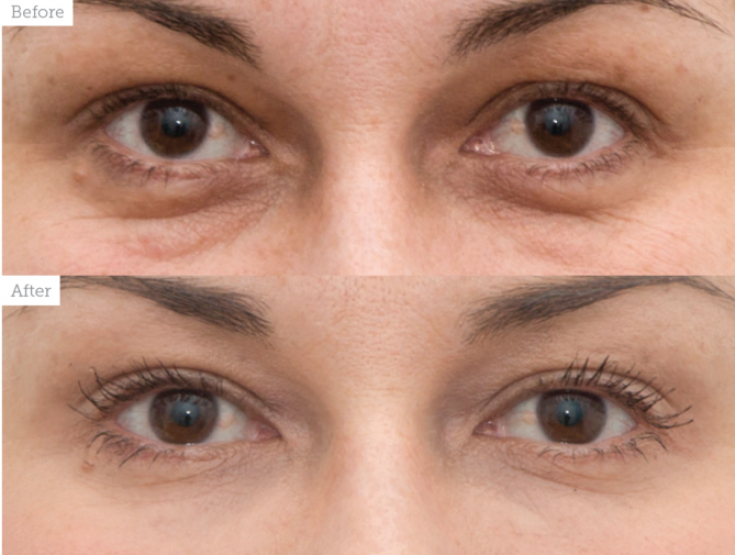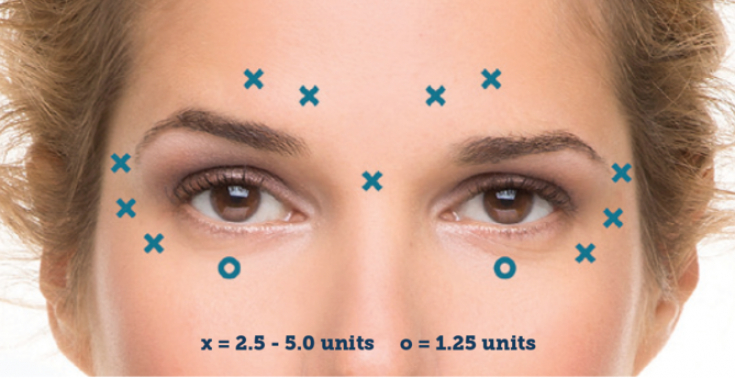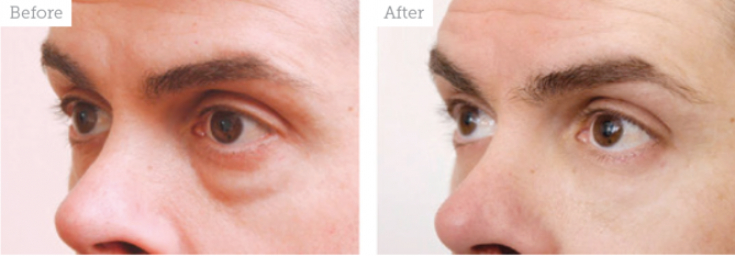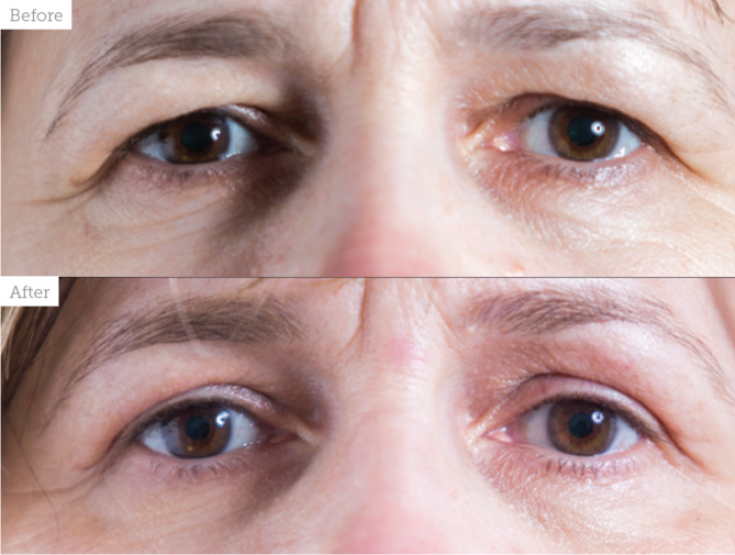Modern tools and preparations allow the esthetician to use an integrated approach to rejuvenate any area of the face. This approach is especially important in the correction of the upper and lower eyelids, since this area is particularly delicate and, accordingly, first of all gives out the patient's age.
Effective anti-age periorbital treatments with minimal downtime and low risk profile, – one of the most sought after aesthetic clinics among patients.
In this article, Dr. Nikola Milojevic talks about one such approach: the use of dermal fillers, botulinum toxin, and plasma correction to reverse the signs of aging in the upper and lower eyelids.
Anatomy and physiology of aging of the periorbital zone
The anatomy and physiology of aging in the upper third of the face is well understood. The appearance of the nasolacrimal groove in the lower eyelid is due to a genetic predisposition associated with the state of the nasolacrimal ligament.
However, in most cases, the deepening or appearance of dark circles under the eyes is the result of atrophy of the medial buccal fat pad and subsequent separation of the infraorbital and buccal fat compartments as a result of gravity.
Decreased skin elasticity and skeletal aging also affect the severity of the nasolacrimal sulcus.
Ptosis of the upper eyelid – another problem characteristic of the periorbital zone, which is caused by a decrease in elasticity and sagging of the skin.
The most sensitive and expressive: the area around the eyes and methods of its correction
Dermal filler injections for periorbital rejuvenation
To perform the procedure described by the author, the physician must have experience with dermal fillers and have excellent knowledge of facial anatomy. It is important to remember that the use of permanent fillers in the periorbital area is contraindicated due to the risk of side effects.
According to the author, cross-linked hyaluronic acid dermal fillers are the only drugs suitable for the correction of the nasolacrimal sulcus, since the side effects of their use can be eliminated by the introduction of hyaluronidase. Also, cross-linking of HA provides a long-term result that lasts for 12-24 months.
Follow us on Facebook
A filler with low elasticity is used to correct the tear trough in patients with shallow dark circles and thin skin. However, in patients with more pronounced bags under the eyes and a significant loss of volume, it is more appropriate to use a filler with high elasticity to volumize the upper cheek.
On average, the author uses 1 ml of filler to correct each side of the face. The author prefers to use a needle as it provides the greater precision required for good results. However, the risk of side effects is lower than when using a cannula.
According to the author, the only drugs suitable for the correction of the nasolacrimal trough are dermal fillers based on cross-linked hyaluronic acid.
It is important to inject the filler deeply, in most cases – directly on the periosteum. In his practice, the author uses various techniques for the introduction of fillers, including:
• bolus;
• linear;
• pyramidal.
For most patients, the author applies all of the above techniques to obtain natural results and minimize side effects. Of course, the appropriateness of using a particular technique is determined by the depth of the nasolacrimal sulcus and the thickness of the skin under the eyes.
In order to correct the nasolacrimal trough and "mask" bags under the eyes, the author performs 30 injections of dermal filler around the eye in the so-called mosaic technique. The author also notes that it is impossible to perform this technique with cannulas.
Lacrimal trough fillers: simple and effective
Massaging the area to be treated and following the doctor's recommendations by the patient plays a huge role in preventing redness, bruising and swelling, which can otherwise persist for a week:
• abstain from exercise and alcohol for 24 hours;
• apply ice and apply arnica gel to treated areas.
In rare cases, long-term swelling, bumps and bumps may appear after correction. These side effects can be eliminated through vibration massage or the introduction of hyaluronidase.
Possible complications after the introduction of fillers:
• allergic reactions;
• infection;
• vascular damage;
• loss of vision.

Figure 1: Patient, 38 years old, before and after correction of bags, dark circles and wrinkles in the eye area with injections of 2 ml of HA filler into the nasolacrimal sulcus, 1 ml of HA filler in the cheek area, as well as injections of botulinum toxin in the area between the eyebrows and around the eyes
Botulinum toxin injections to smooth wrinkles in the periorbital area
The activity of the orbicular muscle of the eye, as well as the loss of skin elasticity, are the main causes of wrinkles around the eyes.
When correcting the nasolacrimal sulcus with fillers, the author often recommends injections of botulinum toxin into the orbicular muscle of the eye for two reasons:
• firstly, the combined procedure provides the best cumulative effect;
• Secondly, this approach allows you to raise your eyebrows and correct the ptosis of the upper eyelid.
The standard dose of botulinum toxin for the eye area is 2.5-5 units per injection. This dose of the drug is administered at three superficial points. To smooth wrinkles around the eyes, it is enough to inject 1.25-2.5 units of botulinum toxin to the central pupillary line (see Fig. 2).

Fig. 2: Botulinum toxin injection points for periorbital rejuvenation
Possibilities of plasma correction for the removal of excess skin in the area of the upper eyelid
Fractional plasma devices generate microcurrents. The generated electrical discharge is delivered through an applicator consisting of a plastic handle and an electrode made of medical grade stainless steel.
Eye area correction: attention to microcirculation
The electrical discharge results in a selective increase in temperature in the target area of the skin through the action of very high energy density. As a result, points of sublimation of superficial corneocytes are created, and the basal layer of cells remains unaffected – thus, a lifting effect is achieved.
Plasma devices can be used to remove excess skin in the upper eyelid area. In most cases, one session is enough, but in some cases, after 4-6 weeks, a second session is required. Also, plasma devices can be used to rejuvenate the entire face, as well as remove moles, xanthomas and even scars.

Fig. 3: female patient, 35 years old, before and 2 weeks after the injection of 2 ml of HA filler to correct bags under the eyes
A local anesthetic is applied to the area of the upper eyelid and crow's feet 45 minutes before the procedure. Before starting work, it is necessary to mark the target area.
Plasma devices can be used to remove excess skin in the upper eyelid area. In most cases, one session is enough, however, in some cases, after 4-6 weeks, a second session is required.
At each point of influence, tissue sublimation occurs, resulting in a tightening effect. Superficial corneocytes are involved in the process of sublimation, while the basal layer of the epidermis is not damaged.

Fig. 4: Patient, 64 years old, before and 4 weeks after 1 plasma treatment of the upper eyelids
The procedure takes about 10-15 minutes and is accompanied by minimal pain. Visible improvement is seen immediately after treatment.
Some patients may experience slight swelling in the treated area, as well as a small crust, which persist for several days and weeks, respectively.
Recommendations for skin care after plasma treatment:
• Use mild skin cleansers;
• apply gauze compresses soaked in normal saline solution twice a day for three days;
• apply sterile Vaseline to the treated area until complete healing;
• apply antibiotic ointment and steroid cream for 6–9 days;
• avoid sun exposure for 7–8 weeks.
The most sensitive and expressive area is around the eyes
Plasma correction in combination with injections of dermal fillers based on HA and botulinum toxin provides effective rejuvenation of the periorbital zone.
Adapted from Aesthetics







Add a comment